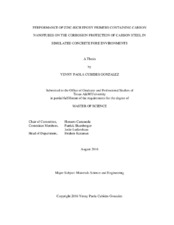| dc.contributor.advisor | Castaneda, Homero | |
| dc.creator | Cubides Gonzalez, Yenny Paola | |
| dc.date.accessioned | 2020-02-27T16:52:27Z | |
| dc.date.available | 2020-02-27T16:52:27Z | |
| dc.date.created | 2016-08 | |
| dc.date.issued | 2016-08-04 | |
| dc.date.submitted | August 2016 | |
| dc.identifier.uri | https://hdl.handle.net/1969.1/187354 | |
| dc.description.abstract | The performance of zinc-rich epoxy primers containing carbon nanotubes (CNT-ZRPs) on the corrosion protection of carbon steel in simulated concrete pore solutions contaminated with chloride ions was investigated. The research project was divided in two main sections; in the first part of this project, the author studied the influence of zinc content on the corrosion protection mechanism of carbon nanotubes/zinc rich epoxy primers on carbon steel under exposure to a simulated concrete pore solution. Based on the zinc content, three mechanisms of corrosion protection were identified. The CNT-ZRP with 60 wt. % Zn exhibited good barrier protection during the entire immersion period as a result of the highly cross-linked character of the epoxy binder. In contrast, the CNT-ZRP with 70 wt. % Zn afforded short-term sacrificial protection to the metallic substrate followed by intermediate barrier protection. Furthermore, it was found that the presence of CNTs in the coating system with 70 wt. % Zn, enhanced the electrical contact between the zinc particles and the carbon steel surface, allowing to provide sacrificial protection to the steel substrate. In addition, CNTs increased the barrier properties of the coating, suggesting that CNTs blocked micropores and defects in the material, hindering the diffusion of electrolyte throughout the coating. Finally, an extended galvanic protection was provided for the CNT-ZRP with 80 wt. % Zn. Insoluble zinc corrosion products were found inside the material and at the coating surface, as a result of the galvanic protection process and a self-corrosion process of the zinc particles. These mechanisms of corrosion protection were characterized quantitatively by electrochemical techniques such as open circuit potential (OCP), electrochemical impedance spectroscopy (EIS), and localized electrochemical impedance spectroscopy (LEIS) and high-resolution techniques such as scanning electron microscopy (SEM) coupled with energy dispersive X-ray spectroscopy (EDS) and X-ray photoelectron spectroscopy (XPS).
In the second part of the research project, the influence of chloride concentration in the simulated concrete pore solution on the corrosion performance of these coating systems was investigated. The corrosion protection mechanisms for the different coating systems were similar to the ones described above, however, the effect of different chloride concentrations in the simulated concrete pore solution was noticeable; it was found that concrete pore environments with low chloride concentration allowed passivation of the carbon steel surface and formation of solid zinc corrosion products. In contrast, simulated concrete pore solutions with high chloride concentration led to breakdown of the passive layer, blister formation, and dissolution of zinc corrosion products previously formed during the sacrificial protection process. | en |
| dc.format.mimetype | application/pdf | |
| dc.language.iso | en | |
| dc.subject | Electrochemical Impedance Spectroscopy (EIS) | en |
| dc.subject | Zinc-Rich Epoxy Primers (ZRPs) | en |
| dc.subject | Carbon Nanotubes (CNTs), Simulated Concrete Pore Solution. | en |
| dc.title | Performance of Zinc-Rich Epoxy Primers Containing Carbon Nanotubes on the Corrosion Protection of Carbon Steel in Simulated Concrete Pore Environments | en |
| dc.type | Thesis | en |
| thesis.degree.department | Materials Science and Engineering | en |
| thesis.degree.discipline | Materials Science and Engineering | en |
| thesis.degree.grantor | Texas A&M University | en |
| thesis.degree.name | Master of Science | en |
| thesis.degree.level | Masters | en |
| dc.contributor.committeeMember | Shamberger, Patrick | |
| dc.contributor.committeeMember | Lutkenhaus, Jodie | |
| dc.type.material | text | en |
| dc.date.updated | 2020-02-27T16:52:27Z | |
| local.etdauthor.orcid | 0000-0002-8874-1924 | |


